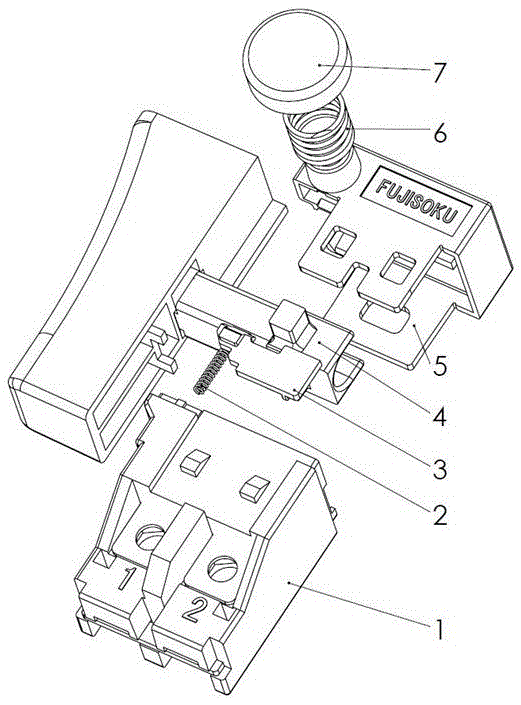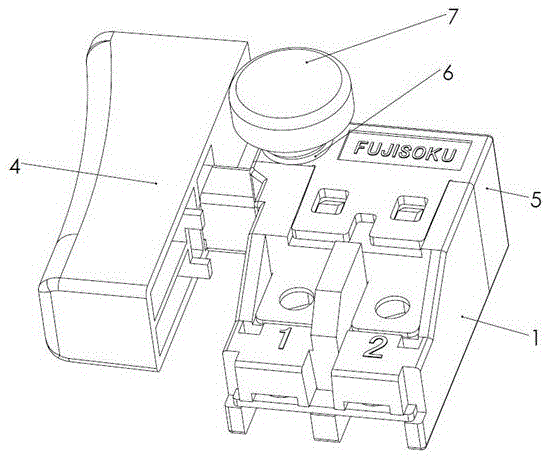Reverse self-locking mechanism of trigger switch
An anti-self-locking and trigger technology, applied in the direction of portable mobile devices, manufacturing tools, etc., can solve the problems of aggravated impact, failure of anti-self-locking mechanism, hidden safety hazards, etc., to increase service life, protect personal safety, and improve fluidity Effect
- Summary
- Abstract
- Description
- Claims
- Application Information
AI Technical Summary
Problems solved by technology
Method used
Image
Examples
Embodiment 1
[0022] see Figure 1~2 , in an embodiment of the present invention, an anti-self-locking mechanism of a trigger switch includes a casing 1, a casing 5 and a trigger 4, the trigger 4 is installed between the casing 1 and the casing 5, and an anti-self-locking mechanism is movably installed on the casing 5 device, the anti-self-locking device includes a limiting groove in the casing 1 and a locking plate 3, the limiting groove is opened in the casing 1, the locking plate 3 is movably installed in the limiting groove inside the casing 1, and the locking plate 3 is It is limited in the limit groove in the casing 1, and can move up and down, and control the movement of the trigger 4. The locking plate 3 and the casing 1 work together to control the trigger 4 to realize the anti-self-locking function.
[0023] The outside of shell 5 is equipped with the anti-self-locking button 7 that controls anti-self-locking device, and the anti-self-locking resetting device that is connected wit...
Embodiment 2
[0028] The shell of an anti-self-locking machine of a trigger switch is prepared according to the following method:
[0029] 1) Weigh each raw material by weight for later use: 1 part of gallium, 1 part of cerium, 1 part of neodymium, 2 parts of glass fiber, 3 parts of niobium, 3 parts of zirconium, 8 parts of zinc, 10 parts of graphite, 10 parts of titanium, and 30 parts of silicon parts, aluminum 80 parts, magnesium 1000 parts;
[0030] 2) Add glass fiber and graphite to acetone in sequence, stir at 100 rpm for 6 hours, and then refrigerate at 4°C for 12 hours to obtain auxiliary materials; wherein, the mass ratio of acetone to graphite is 2:1;
[0031] 3) Preheat gallium, cerium, neodymium, niobium, zirconium, zinc, titanium, silicon, aluminum and magnesium at 200°C for 1 hour;
[0032] 4) Use a crucible resistance furnace to melt the preheated magnesium, then add auxiliary materials, zinc, silicon and aluminum at 750 ° C, and stir the melt for 3 minutes; continue to heat ...
Embodiment 3
[0035] Comparative Experiment 1: The process steps are the same as in Example 2, except that graphite and glass fibers are not added.
[0036] Comparative Test 2: The process steps are the same as in Example 2, except that gallium, cerium, neodymium, niobium and zirconium are not added.
PUM
 Login to View More
Login to View More Abstract
Description
Claims
Application Information
 Login to View More
Login to View More - R&D
- Intellectual Property
- Life Sciences
- Materials
- Tech Scout
- Unparalleled Data Quality
- Higher Quality Content
- 60% Fewer Hallucinations
Browse by: Latest US Patents, China's latest patents, Technical Efficacy Thesaurus, Application Domain, Technology Topic, Popular Technical Reports.
© 2025 PatSnap. All rights reserved.Legal|Privacy policy|Modern Slavery Act Transparency Statement|Sitemap|About US| Contact US: help@patsnap.com



